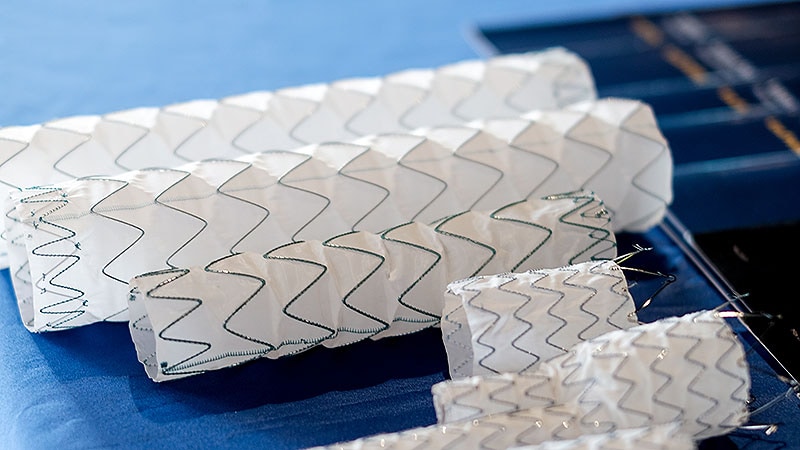An “optical biopsy” of intravascular plaque during stenting is more effective at reducing the rate of restenosis or thrombosis in people with moderately or severely calcified lesions than angiography guidance, a substudy of the ILUMIEN IV clinical trial has found.
“We found that in those calcified lesions there was a marked benefit of optical coherence tomography [OCT] guidance compared with angiography guidance in improving long-term outcomes, specifically in reducing the 2-year rate of target vessel failure and serious adverse cardiovascular events, as well as stent thrombosis,” study leader Gregg Stone, MD, director of academic affairs for Mount Sinai Heart Health System in New York City, told Medscape Medical News.
Results of the analysis were published in the European Heart Journal.
Substudy Results
The study included 2114 patients from the ILUMIEN IV clinical trial, which compared OCT- and angiography-guided percutaneous coronary intervention (PCI). The participants in the substudy had a single treated calcified lesion in a major epicardial vessel. On angiographic guidance, 1082 patients (51.2%) had a moderately or severely calcified lesion and 1032 (48.8%) had no or mild calcification.
Using angiographic guidance alone, the rate of target vessel failure at 2 years in the moderately or severely calcified lesions was 93% greater than that in the lesions with no or mild calcification (9.7% vs 5.2%).
However, with OCT guidance, the 2-year rates of failure were similar in both groups, 6.8% in the moderately and severely calcified lesions and 7.7% in the no or mildly calcified lesions.
With OCT guidance, the 2-year failure rates were 38% lower compared with angiography guidance in the patients with moderately and severely calcified lesions: 6.8% vs 9.7%. The differences in the patients with no or mild calcification were not statistically significant, the substudy found: 7.7% with OCT guidance and 5.2% with angiographic guidance (P = .01).
The three major predictors of vessel failure after PCI, Stone said, are minimal stent area and a major dissection or untreated disease at the edge of the stent. “The real advantage of optical coherence tomography is that it provides a much more accurate picture than angiography in determining the minimal stent area or in detecting edge-related dissections or significant untreated disease,” he said.
The 2024 European Society of Cardiology guidelines recommend intravascular imaging as a Class IA indication for anatomically complex lesions, Stone noted; but those guidelines do not specifically call out calcified lesions. “That’s the major gap this study fills,” he said.
The American College of Cardiology, in conjunction with the American Heart Association and the Society for Cardiovascular Angiography and Intervention, this year issued a Class 1A recommendation for intracoronary imaging, including OCT, during stenting of the left main artery or for other complex lesions.
‘Directly Relatable to the Clinic’
While OCT operators need a high level of skill to perform the imaging and interpret the results, the substudy findings are “quite generalizable to all settings,” Stone said.
“These findings are directly translatable to the clinic, but there’s always more fine tuning that can be performed,” he added. That refining would include clarification of the characteristics of calcified plaque on OCT that are at highest risk for target vessel failure, and possibly the need for an advanced strategy of lesion preparation, using either lithotripsy, atherectomy or cutting or scoring balloons, he said.
Several calcium scoring classifications for OCT have been proposed, but none has been clinically validated. “That would be a rich area for future research,” Stone said.
Clinical Context
The new data underscore the value of intravascular imaging, and add to the data supporting OCT specifically, for characterizing plaque in percutaneous coronary intervention, Yader Sandoval, MD, an interventional cardiologist at the Minneapolis Heart Institute at Abbott Northwestern Hospital and cochair for the Center for Coronary Artery Disease at the Minneapolis Heart Institute Foundation, Minneapolis, told Medscape Medical News.
“This analysis of ILUMIEN IV complements and further adds that this is the right direction that intravascular imaging not only provides superior technical results but it improves outcomes for these patients,” Sandoval said.
The substudy clears up a finding from the original ILUMIEN IV study that, while OCT guidance resulted in a larger minimal stent area than angiography guidance, it did not necessarily reduce target vessel failure at 2 years.
A strength of the ILUMIEN IV trial was the “meticulous core laboratory data analysis” used, along with its global scope, he said.
The substudy, also reported using OCT guidance, took about 16 minutes longer per procedure than angiography (67.7 minutes vs 51.5 minutes) and required longer fluoroscopy duration and greater total radiation dose, Sandoval said, which could raise questions about the practicality of OCT for this indication.
“The main message is, you are better characterizing calcium and therefore better preparing the lesion and providing a better technical result, better area, and better results for the patient,” he said. “That comes with the investment that the procedure is little more complex, and you have to do a better job of preparing the lesion. And to me these data elegantly show that.”
Abbott Vascular provided funding for this study. Stone reported receiving speaking fees from Abbott. Sandoval reported serving as a consultant, advisory board member, and a speaker for Abbott.
Richard Mark Kirkner is a medical journalist based in Philadelphia.
Source link : https://www.medscape.com/viewarticle/oct-bests-angiography-guidance-improving-pci-outcomes-2025a1000hlf?src=rss
Author :
Publish date : 2025-07-02 09:54:00
Copyright for syndicated content belongs to the linked Source.
